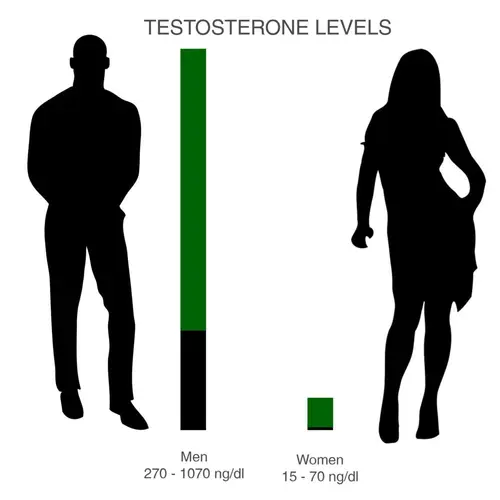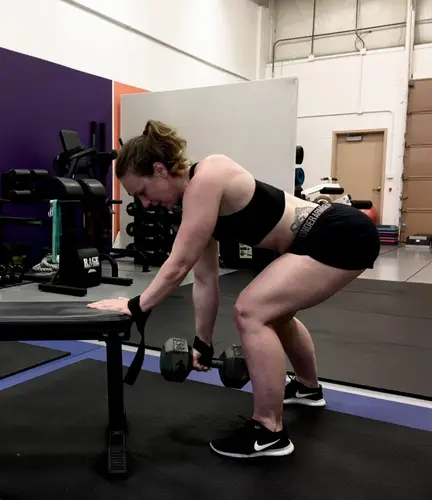Women, weights and bulking up
Women and resistance training: one of the most common concerns among women who start working out with weights is “bulking up like a man.” But is this a realistic possibility?
It’s not uncommon to see women sticking to light dumbbells, avoiding the free weights area, or joining a gym simply to use the treadmills and ellipticals. However, resistance training brings great benefits for women:
- Helps build a lean and sculpted physique
- Increases basal metabolic rate
- Prevents osteopenia and osteoporosis in later years
The idea that a woman will look like a man by working out with weights is inaccurate. While there are muscular women who may appear “manly,” achieving this look typically requires a regimen of hormone treatments (steroids) and intense, specialized training.
In reality, weightlifting helps women develop strength and tone without excessive bulk. The average woman lacks the testosterone levels necessary to build muscle mass comparable to men. Instead, resistance training can create a strong, defined, and feminine physique.
Elements to build muscle mass
There are several essential elements needed to build muscle:
- Intense resistance training
- Proper nutrition
- Adequate rest
- Hydration
However, testosterone is possibly the most important factor. Testosterone is an androgenic hormone that is produced in both men and women but at different levels.
Testosterone plays a crucial role in muscle development and growth. It stimulates protein synthesis, increases growth hormone responses to exercise, and helps to activate satellite cells, which are essential for muscle repair and growth.
The significant difference in testosterone levels between men and women is a primary reason why women typically don’t “bulk up” like men when engaging in resistance training:
- Men generally produce 10-30 times more testosterone than women.
- Average testosterone levels in adult men range from 270-1,070 ng/dL.
- Average testosterone levels in adult women range from 15-70 ng/dL.
This hormonal difference explains why most women can engage in intense weight training without developing the same level of muscle mass as men. Instead, resistance training for women usually results in a toned, lean, and strong physique without excessive bulk.

The elevated levels of testosterone and lower levels of estrogen give men their typical look, even without exercising. In the same way, lower levels of testosterone and elevated levels of estrogen make women look like women, even if they lift weights at maximum intensity.
The reality of resistance training
Our bodies change through adaptation. People who routinely walk long distances develop the endurance needed to accomplish that task without struggle. Similarly, individuals who lift heavy weights become stronger to handle those loads effectively.
By engaging in a well-designed resistance training routine, we are challenging our muscles to adapt to new demands. It’s crucial to understand that without a challenge, the body won’t change, as there is no need for adaptation.
This principle of adaptation applies to various aspects of fitness:
- Cardiovascular endurance: Regular aerobic exercise leads to improvements in heart and lung capacity.
- Muscular strength: Lifting progressively heavier weights causes muscle fibers to grow and strengthen.
- Flexibility: Consistent stretching increases range of motion and muscle elasticity.
- Bone density: Weight-bearing exercises stimulate bone growth and increase density.
The key to effective training is progressive overload – gradually increasing the demand on the body over time. This could mean:
- Increasing the weight lifted
- Performing more repetitions
- Reducing rest periods between sets
- Increasing the complexity of exercises
It’s important to note that adaptation is specific to the type of training performed. For example, training for marathon running won’t necessarily improve your ability to lift heavy weights, and vice versa.
Understanding this principle of adaptation can help individuals tailor their fitness routines to their specific goals, whether that’s building strength, improving endurance, or enhancing overall fitness.
Bulking up
There is a significant difference between “bulking up” and building lean muscle. Even though women don’t have the same natural capacity for muscle growth as men, they can still build muscle, albeit in smaller amounts.
In recent years, the fitness landscape has evolved, particularly on social media:
- A large number of “influencers” now showcase lean bodies with well-developed musculature.
- The traditional “catwalk look” has been largely replaced by more fit-looking models.
- Instagram celebrities like Jen Selter, Michelle Lewin, and Ana Cheri have made a muscular physique the trendy aesthetic.
These influential figures typically display:
- Good muscle tone
- Low body fat percentage
This combination contributes to their iconic look, which has become increasingly popular and aspirational.
Key points to understand:
- Muscle building in women: While women generally build muscle at a slower rate and with less overall volume compared to men, they can achieve significant improvements in muscle tone and definition.
- The role of body fat: A low body fat percentage is crucial for revealing muscle definition. This is often achieved through a combination of resistance training and careful nutrition.
- Individualized results: The exact appearance will vary based on factors such as genetics, training intensity, diet, and overall lifestyle.
- Sustainable approach: Achieving and maintaining this look typically requires consistent effort and a balanced approach to fitness and nutrition.
- Changing beauty standards: This shift in ideals demonstrates how societal perceptions of beauty and fitness continue to evolve.
It’s important to note that while this look has become popular, it’s not the only definition of health or beauty. Each individual should pursue fitness goals that align with their personal preferences and overall well-being.
Skinny or Lean?
There is a crucial difference between losing weight (being small) and being lean. This distinction is often misunderstood:
- Weight Loss vs. Leanness:
- Weight loss simply refers to a reduction in overall body mass.
- Leanness specifically relates to having a low body fat percentage.
- Limitations of the scale:
- The scale is accurate for measuring total body weight.
- However, it fails to provide information about body composition (fat vs. muscle).
- Definition of leanness:
- Being lean means having a low body fat percentage relative to total body mass.
- It’s possible to be lean at various weights and sizes.
- BMI limitations:
- Body Mass Index (BMI) is a simple measure using height and weight.
- While useful for population studies, BMI doesn’t account for body composition.
- Someone can have a low BMI but still have a high body fat percentage.
- The “skinny fat” phenomenon:
- It’s not uncommon to see “treadmill warriors” with a low BMI (e.g., 5’6″ and 120lbs, BMI < 20).
- These individuals may have a relatively high body fat percentage despite being “small.”
- They often have very low muscle mass, contributing to a higher body fat percentage.
- Importance of body composition:
- Health and fitness are more closely related to body composition than to weight alone.
- A balance of lean muscle mass and low body fat is generally considered ideal for health and aesthetics.
- Methods for assessing leanness:
- Body fat calipers
- Bioelectrical impedance
- DEXA scans
- Hydrostatic weighing
- Benefits of being lean vs. just being small:
- Improved metabolic health
- Better athletic performance
- Enhanced physical appearance
- Potentially reduced risk of certain health conditions
This understanding highlights the importance of focusing on body composition rather than just weight or BMI. A comprehensive fitness approach should aim for a balance of muscle building and fat loss, rather than simply pursuing a lower number on the scale.
BENEFITS OF RESISTANCE TRAINING
Helping with posture
We all live in an asymmetrical world, where our daily habits often compromise our body’s symmetry and muscular balance. Common examples include:
- Carrying grocery bags, purses, or briefcases with the same hand consistently
- Sitting for extended periods
- Always using the same leg to exit a vehicle
These unavoidable activities can lead to muscular imbalances and postural issues over time.
Let’s consider the impact of prolonged sitting in an office environment:
- Postural changes:
- Stretching of the lower and upper back muscles
- Compression of hip flexors, abdominals, and chest muscles
- Resulting conditions:
- Flat-back syndrome
- Rounded shoulders
- Associated aches and pains
The cumulative effect of these habits can lead to chronic discomfort and potential long-term health issues.
However, with the help of a personal trainer, by incorporating proper resistance training into our routines, we can counteract these imbalances:
- Strengthening the back muscles
- Stretching and toning the hips, abs, and chest
Benefits of targeted resistance training:
- Improved posture:
- Achieving a more neutral and balanced body alignment
- Pain prevention:
- Reducing the likelihood of aches associated with poor posture
- Enhanced functionality:
- Improving overall movement patterns and body awareness
Implementing a well-designed resistance training program can:
- Address muscle imbalances
- Improve flexibility in tight areas
- Strengthen weak muscle groups
- Promote better overall body mechanics
It’s important to note that a comprehensive approach should include:
- Resistance training
- Stretching and mobility work
- Ergonomic adjustments to your work environment
- Mindful movement throughout the day
By taking a proactive approach to counteract our daily postural challenges, we can significantly improve our physical well-being and prevent many common musculoskeletal issues.
Bone density
Resistance training is a key recommendation from medical professionals for preventing osteopenia and osteoporosis, especially in women. Here’s an expanded look at this topic:
- Medical Recommendations:
- Resistance training is often among the first suggestions from doctors for bone health.
- It’s considered a crucial preventive measure against bone density loss.
- Hormonal Factors in Women:
- Testosterone and estrogen levels play significant roles in muscle and bone health.
- As women age, these hormone levels naturally decline, leading to: a) Accelerated muscle loss (sarcopenia) b) Rapid decrease in bone density
- Relationship Between Muscle and Bone Density:
- Muscle density and bone density are closely interrelated.
- Adding muscle mass through resistance training can help increase bone density.
- How Resistance Training Helps:
- Stress on bones during weight-bearing exercises stimulates bone formation.
- This process, known as Wolff’s Law, states that bones adapt to the loads placed upon them.
- Regular resistance training can lead to increased bone mineral density over time.
- Benefits for Women:
- Helps counteract the natural decline in bone density post-menopause.
- Can reduce the risk of fractures and falls in older age.
- Improves overall strength and functional capacity.
- Types of Effective Resistance Training:
- Weight lifting (free weights or machines)
- Bodyweight exercises (push-ups, squats, lunges)
- Resistance band workouts
- High-impact activities (jumping, running) also contribute to bone strength
- Complementary Factors:
- Adequate calcium and vitamin D intake is crucial for bone health.
- Balanced nutrition supports both muscle growth and bone density.
- Long-term Health Implications:
- Reducing the risk of osteoporosis can lead to better quality of life in later years.
- Maintaining muscle mass and bone density supports independence and reduces the risk of disability.
- Recommendations for Implementation:
- Start resistance training early as a preventive measure.
- Consistency is key – regular, long-term engagement provides the best results.
- Gradually increase intensity and weight as strength improves.
It’s important to note that while resistance training is highly beneficial, individuals should consult with healthcare professionals before starting a new exercise regimen, especially those with pre-existing conditions or concerns about bone health.

” In my own personal case, “intensity” is the name of the game. I enjoy and take pride in pushing one more repetition,
moving up to the next dumbbell and simply getting stronger…

…Despite lifting heavy and intensely, nobody has ever accused me of looking like a man.”
Peyton M.
